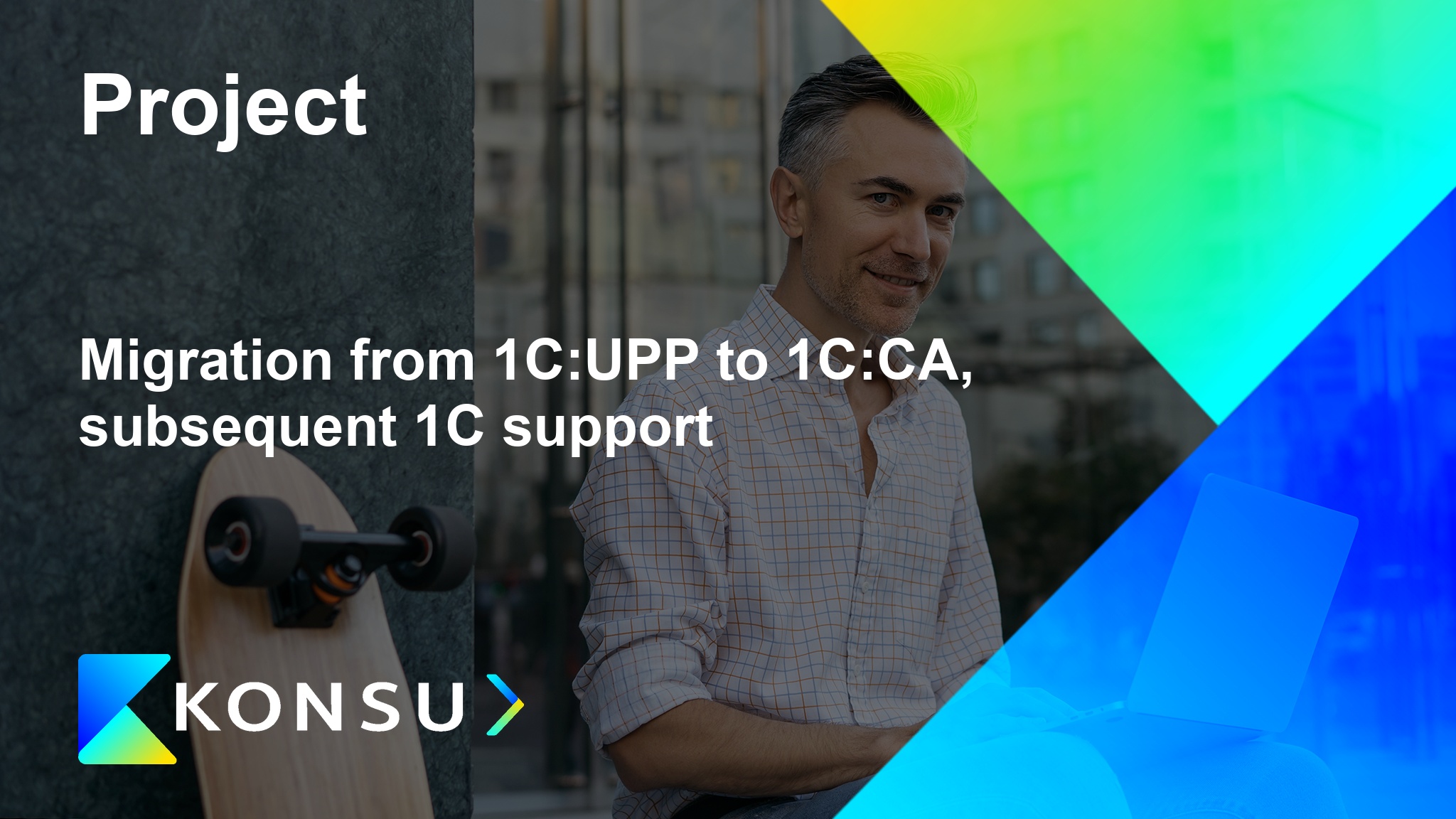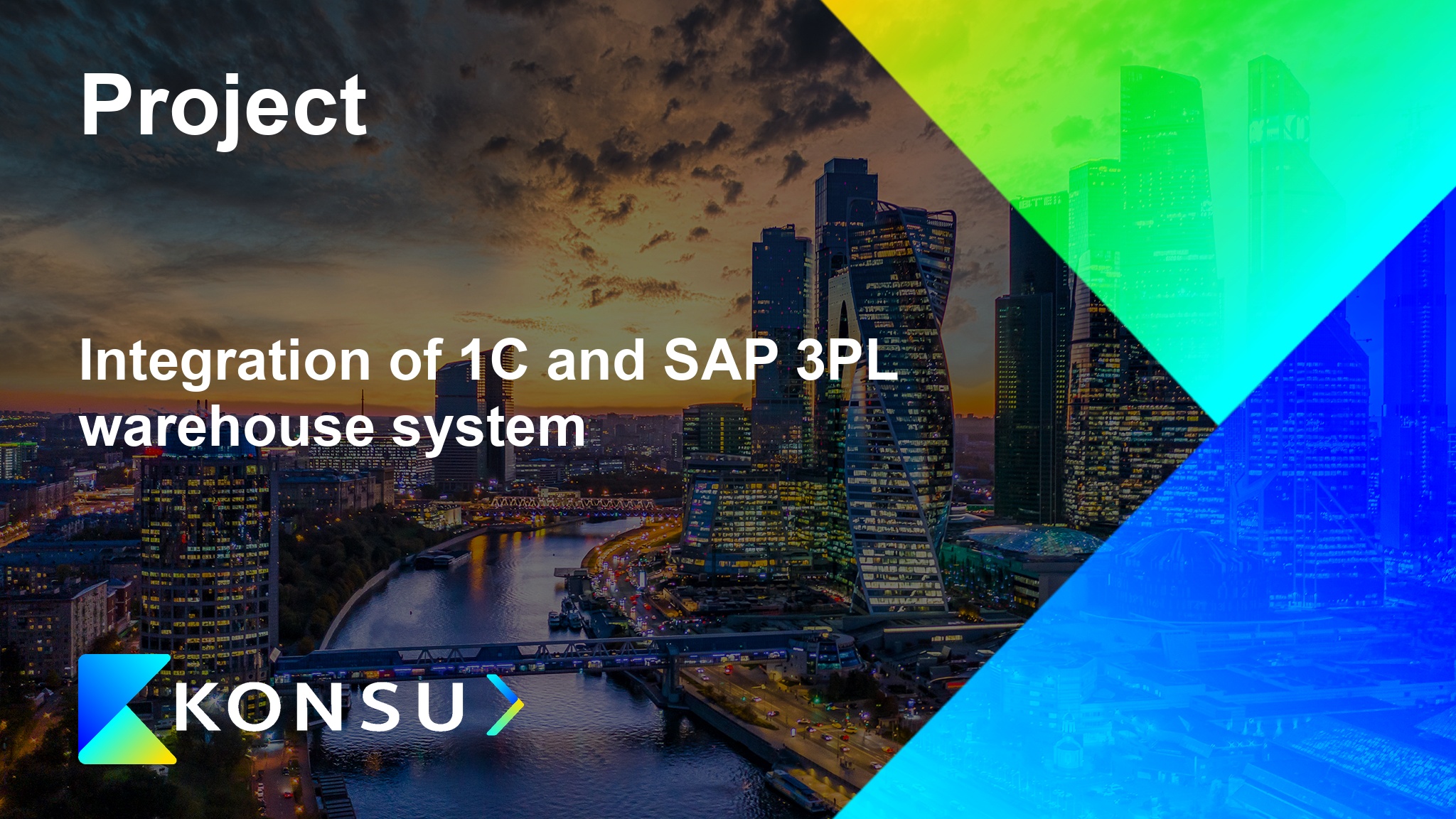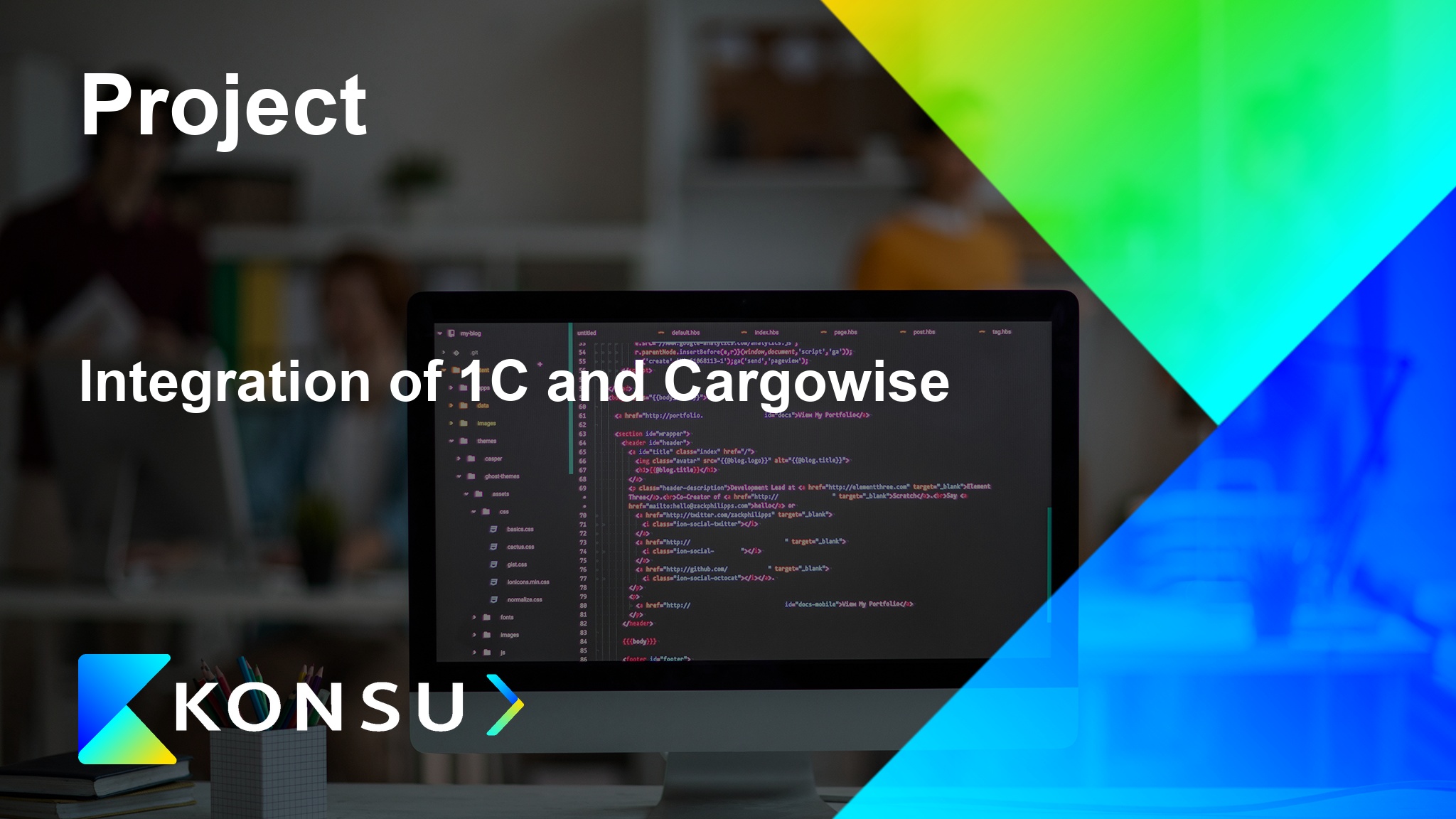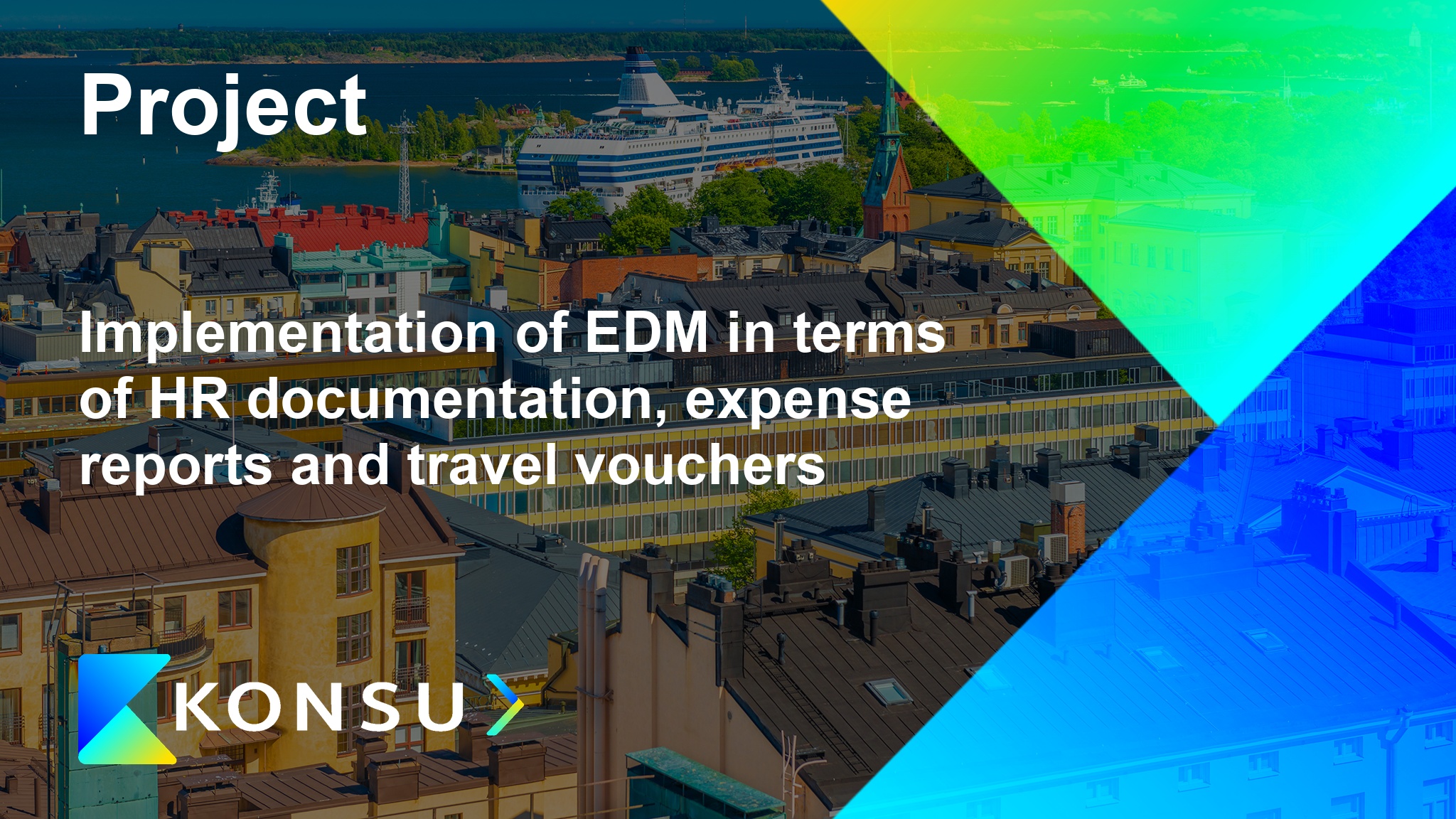Migration from 1C:UPP to 1C:CA, subsequent 1C support
Client
Activity: supply of products for fast food outlets, rental of equipment for fast food preparation.
Previously used systems: 1C:UPP.
Customer volumes: 100 employees, more than 8,000 documents per month.
Objectives
- Migration to the current 1C:CA product from 1C:UPP and setting up integration with 1C Document Management, EDI Contour, 1C:ZUP, customer order processing system, warehouse system of the logistics partner;
- Waiver of internal IT service;
- Automate IFRS report generation;
- Further support of the client's 1C products. Gathering business requirements, development, testing, implementation of 1C enhancements.

Project stages
- Developed a wizard for transferring balances and actual directories from 1C:UPP to 1C:CA;
- Analyzed client processes in 1C:UPP, agreed and implemented improvements in 1C:CA, including IFRS report;
- Reconfigured and automated integrations with 1C Document Management, 1C:ZUP, as well as exchanges with EDI, EDM and client portals;
- Two-way exchange between 1C:CA and the internal warehouse system of the logistics partner.
Results:
- All client’s operations since the beginning of the year were migrated to the current 1C:CA product without the need to stop daily operational activities of the client;
- Monthly 1C support services are provided through the ticketing tool system, which eliminated the need to maintain an internal IT service;
- The IFRS report was automated.
Audit of IT landscape and business systems
Client
Activity: one of the world's largest suppliers of household chemicals and personal care products. The business is conducted through distribution companies.
Objective
Conduct an audit of IT infrastructure and business processes.

Work stages
- the current structure and configuration of the IT landscape for compliance with fault tolerance, security, and efficiency criteria
- end to end transactional business process to confirm a sufficient level of control and data traceability
- business processes related to finalization of applied IT systems
- the process of making changes to databases, sufficiency of control;
- the process of data logging and archiving, its compliance with the customer's requirements
- the process of reporting to the customer on the results of the distributor's activities
Results:
- Identified critical deviations in several processes
- Recommendations for improving the IT landscape were offered
- The company’s IT structure and processes were assessed using COBIT methodology
- A comparative analysis with assessments of similar companies in the industry was carried out
Lead time from audit plan to report is 1.5 months.
Migration from 1C:Accounting/Axapta to 1C:ERP
Client
Activity: Production of building materials and metal products.
Volumes: more than 100 production operations per day
Objectives
Previously used systems: 1C Accounting, Axapta.
It is necessary to realize:
- Transition from Axapta foreign production accounting system to 1C:ERP;
- Alignment of the IT landscape by switching from 1C:Accounting to 1C:ERP.

Project stages and methods
- Data upload from Axapta by analytics in .xls format
- Adaptation of the data transfer system to the developed templates
- Loading data on directories and balances from two sources: 1C:Accounting and Axapta into 1C:ERP
- Analysis of customer processes and adaptation of 1C:ERP to these processes
- Training and consulting of the customer's users to work in the new system
Results:
- Combined accounting and management accounting in a single 1C:ERP system within the agreed timeframe – 4 months
- The process of supplying production with materials was implemented
- Fully automated accounting of production operations in 1C:ERP
- ERP dispatcher workstation adapted to business processes and company specifics
- Current support of users on three lines is carried out
- Migration to Konsu cloud servers was made
Migration from Axapta to 1C Corporate Solution
Client
Activity: Retail trade network.
Scale: more than 50 retail outlets in Moscow and regions of the Russian Federation, dedicated warehouse for online store.
Objectives
After expanding operations and taking over another chain, the task of integrating the new stores came up:
- Transition from foreign accounting system Axapta to the finalized corporate solution of the client 1C:UPP;
- Term - 2 months;
- Transfer not only balances, but also information and analytics on income and expenses for the first half of the year.

Project workflow
- Data upload from Axapta in terms of analytics, balances in .xls format;
- Adaptation of the data transfer system to the developed templates;
- Control over the project implementation, including the client's employees.
Results:
- Transferred income and expense balances and turnovers in the required analytics;
- Transferred tax accounting data;
- Work started on the scheduled date by all client’s outlets from the new legal entity and in the new system;
- Business processes adapted to the group of companies;
- Downloaded data reworked in accordance with the new requirements of the accounting system 1C:UPP.
Integration of 1C and SAP 3PL warehouse system
Client
Activity: Wholesale of products for fast food restaurants. More than 100 shipments per day. 3PL warehouse services are provided by a specialized company.
Objectives
Automate the exchange of data on warehouse operations in Moscow and St. Petersburg:
- receipts
- shipments
- interstore transfers
- returns
- daily stocktaking
- delivery routes
Automate the exchange of counterparty and nomenclature data.

Methods of integration
- Exchange of xml files via the logistics partner portal. The exchange takes place in the background in both directions.
Results:
- Real-time information exchange with 3PL warehouse
- Real-time tracking of information shipment statuses
- Ability to plan and control shipments taking into account current information from the warehouse
Integration of 1C and Oracle Opera
Client
Russian company with foreign participation.
Activity: Hospitality business.
Objectives
Opera is an accounting system for collecting data on guest stays and related services.
Tasks:
- Uploading data on invoices issued to guests for accommodation services to 1C:BP
- Daily receipt of revenue data from all hotel terminals

Methods of integration
- Exchange of csv files via ftp. Control of changes in previous periods.
Result:
- Reduced communication between back office and accounting staff
- No need to enter data twice in different systems
- Daily collection of voluminous data in the context of various revenue analytics
- Automatic issuance of sales documents for buyers of legal entities
Integration of 1С & Oracle Materials Control
Client
International company.
Activity: Hotels.
Objectives
Oracle Materials Control – product accounting system for hotel catering.
Requirements:
- Upload from Oracle Materials Control to 1C data on written-off products, alcohol for correct cost accounting
- Accounting by nomenclature is performed in Oracle Materials Control. In 1C - simplified accounting only for calculation purposes
- Collection of cost accounting data in the context of restaurants, hotel bars and in the context of types of expenses

Implemented solution
- Exchange of csv files via sftp.
- Control of changes in previous periods.
Result:
- Reduced communication between back office and accounting staff
- No need to enter data twice in different systems
- Timely receipt of information on inventory and shortages by the accounting department
Integration of 1C and Cargowise
Client
International logistics company: road, rail, air transport.
Objectives
Cargowise - a system for operational accounting of logistics operations. Required:
- Upload of invoicing data to 1C BP
- Upload to 1C BP data on sales by analytics of individual shipments
- Maintain accounting and grouping of Revenues/Expense by transportation numbers from Cargowise
- Upload to 1C BP data on invoices of transportation service providers, including agency contracts

Integration solutions
- Exchange of xml files via ftp.
- Control of changes in previous periods.
Results:
- Reduced communication between back office and accounting staff
- No need to enter data twice in different systems
- Timely receipt of information on realizations by accounting department
- Tracking of transportation profitability in 1C BP
Passing a desk audit on VAT refund
Client
International company.
Activity: Wholesale of additives.
Objectives
Passing a tax audit and reimbursement of VAT claimed for deduction in Q2 2023. The situation was complicated by the fact that the client's supplier filed an amended VAT declaration during the period of the desk tax audit, zeroing out the sales ledger data and causing a tax gap.

Work stages
- Preparation of a response to a request from the Federal Tax Service.
- Preparation of documents to respond to the demand.
- Accompanying the client during an on-site inspection of the client's office or warehouse.
- Preparation of documents and information to defend the client's position on the correctness of tax base formation for export supplies.
Result: VAT was reimbursed in full (RUB 6.5 million).
Implementation of EDM in terms of HR documentation, expense reports and travel vouchers
Client
Representative office of a foreign company.
Sector: pharmaceuticals.
Objectives
Implementation and transition to EDM for personnel records, advance reports and travel vouchers.
Term: 4 months.

Work stages
- Gathering business requirements.
- Description of processes.
- Proposal and coordination of automation options with the client.
- EDM implementation in the following order: HR documents, advance reports, travel vouchers.
- Training of the client's employees.
Result: Automated HR document flow processes, reduced labor costs of the client’s employees on HR administration, minimized the main risks of the company on personal income tax, associated with the lack of documents confirming the economic feasibility of expenses on company cars.









